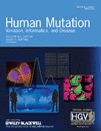 Welander distal myopathy (WDM) is an adult onset autosomal dominant disorder characterized by distal limb weakness which progresses slowly from the fifth decade. All WDM patients are of Swedish or Finnish descent and share a rare chromosome 2p13 haplotype. In this study, the WDM associated haplotype was restricted, followed by whole exome sequencing. Within the conserved haplotype we identified a single heterozygous mutation c.1150G>A (p.E384K) in TIA1 in all WDM patients investigated (n = 43). The TIA1 protein regulates splicing and translation through direct interaction with mRNA and the p.E384K mutation is located in the C-terminal Q-rich domain that interacts with the U1-C splicing factor. TIA1 has been shown to prevent skipping of SMN2 exon 7 and the results show that WDM patients have increased levels of spliced SMN2 in skeletal muscle cells when compared to controls. Immunostaining of WDM muscle biopsies showed accumulation of TIA1 and stress granulae proteins adjacent to intracellular inclusions, a typical finding in WDM. The combined findings strongly suggest that the TIA1 mutation causes perturbed RNA splicing and cellular stress resulting in WDM. The selection against the mutation is likely to be negligible and the age of the TIA1 founder mutation was calculated to approximately 1050 years, which coincides with the epoch of early seafaring across the Baltic Sea.
Welander distal myopathy (WDM) is an adult onset autosomal dominant disorder characterized by distal limb weakness which progresses slowly from the fifth decade. All WDM patients are of Swedish or Finnish descent and share a rare chromosome 2p13 haplotype. In this study, the WDM associated haplotype was restricted, followed by whole exome sequencing. Within the conserved haplotype we identified a single heterozygous mutation c.1150G>A (p.E384K) in TIA1 in all WDM patients investigated (n = 43). The TIA1 protein regulates splicing and translation through direct interaction with mRNA and the p.E384K mutation is located in the C-terminal Q-rich domain that interacts with the U1-C splicing factor. TIA1 has been shown to prevent skipping of SMN2 exon 7 and the results show that WDM patients have increased levels of spliced SMN2 in skeletal muscle cells when compared to controls. Immunostaining of WDM muscle biopsies showed accumulation of TIA1 and stress granulae proteins adjacent to intracellular inclusions, a typical finding in WDM. The combined findings strongly suggest that the TIA1 mutation causes perturbed RNA splicing and cellular stress resulting in WDM. The selection against the mutation is likely to be negligible and the age of the TIA1 founder mutation was calculated to approximately 1050 years, which coincides with the epoch of early seafaring across the Baltic Sea.
